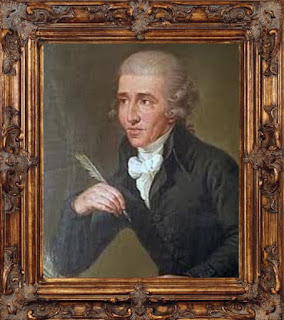Symphony No. 44 has 4 movements:
I. Allegro con brio - The movement begins with a 4-note motif that is heard throughout the movement in various keys and guises. Haydn was very adept at constructing an entire movement from a short motif, and it is one part of his style that Beethoven his student must have admired as he used the same technique in some of his music.
II. Menuetto: Allegretto,canon in diapason - Here Haydn reverses the order of the inner movements and balances the first and third movement's emotions and moods with a minuet. But it is not a typical minuet of the time. First off, it is in the same key as the opening movement. In fact, the first, second and third movements of the symphony have the same home key of E minor. Haydn also writes the minuet in canon; the first measure is heard in the higher strings, the lower strings enter one bar later while the upper strings continue. The low strings remain one bar behind, even lagging two bars behind in one section, until the trio which is very short.

III. Adagio - If tradition is to believed, Haydn himself gave the symphony the nickname 'mourning', in no small part because of this movement. Haydn must have had a real liking for this music, as later in life he requested that it be played at his funeral. The key is E major, the melody is played in muted violins and is not a funeral dirge by any means. It is gentle, graceful music that perhaps reflects Haydn's deeply Catholic religious views about death.
IV. Finale: Presto - The theme of this movement is first heard in unison from the orchestra and careens through the entire movement at a fast pace. The drama stated in the first movement is intensified in this very rapid Haydn finale until the music finally halts with two loud chords.


Thanks for these helpful and beautifully presented notes.
ReplyDeleteThanks for the information
ReplyDeleteI like the information Thankyou
ReplyDeleteMenuetto II: Allegretto, Canon in Diapson - Aquí, Haydn invierte el orden de las secciones internas y usa un minueto para armonizar los sentimientos y estados de ánimo del primer y tercer movimiento. Pero difiere del minueto estándar del día. Comparte la misma tonalidad que el movimiento de apertura, para empezar. En realidad, el primer, segundo y tercer movimiento de la sinfonía utilizan la misma tonalidad fundamental de mi menor. El minueto de Haydn está escrito de manera similar en canon; las cuerdas más altas tocan el compás de apertura, las cuerdas más bajas entran en un compás más tarde y las cuerdas más altas continúan. Hasta el trío, que es bastante breve, las cuerdas inferiores se arrastran un compás, a veces incluso dos compases.
DeleteThanks! Very helpful info.
ReplyDeleteHaydn's genius us not fully acknowledged. For sheer expressiveness and depth of emotion, the slow movement of this symphony is superlative, com0arable, perhaps with the lyrical intensity of the adagio movement of symphony number 88.
ReplyDelete